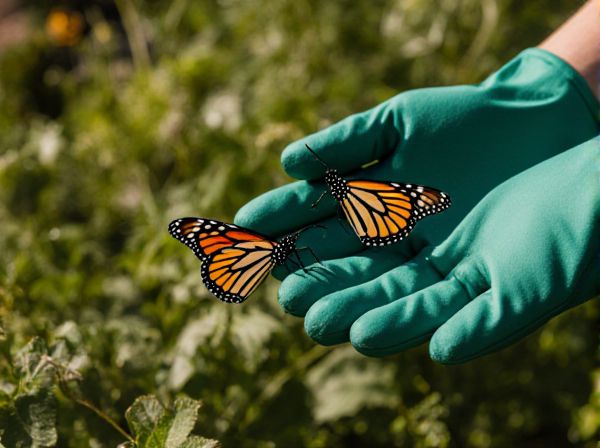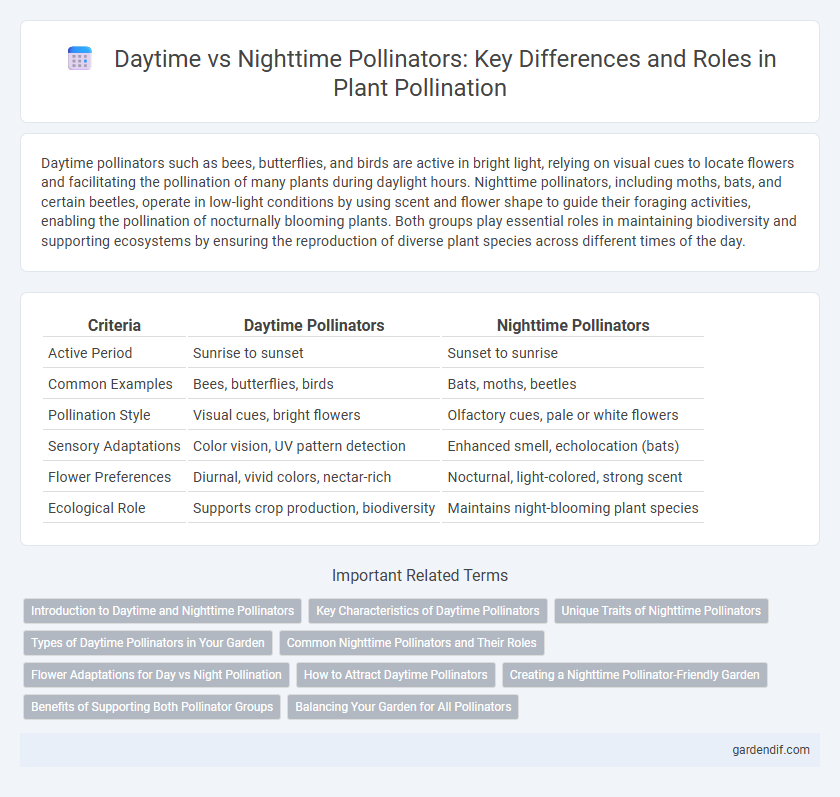
Daytime Pollinators vs Nighttime Pollinators Illustration
Daytime pollinators such as bees, butterflies, and birds are active in bright light, relying on visual cues to locate flowers and facilitating the pollination of many plants during daylight hours. Nighttime pollinators, including moths, bats, and certain beetles, operate in low-light conditions by using scent and flower shape to guide their foraging activities, enabling the pollination of nocturnally blooming plants. Both groups play essential roles in maintaining biodiversity and supporting ecosystems by ensuring the reproduction of diverse plant species across different times of the day.
Table of Comparison
| Criteria | Daytime Pollinators | Nighttime Pollinators |
|---|---|---|
| Active Period | Sunrise to sunset | Sunset to sunrise |
| Common Examples | Bees, butterflies, birds | Bats, moths, beetles |
| Pollination Style | Visual cues, bright flowers | Olfactory cues, pale or white flowers |
| Sensory Adaptations | Color vision, UV pattern detection | Enhanced smell, echolocation (bats) |
| Flower Preferences | Diurnal, vivid colors, nectar-rich | Nocturnal, light-colored, strong scent |
| Ecological Role | Supports crop production, biodiversity | Maintains night-blooming plant species |
Introduction to Daytime and Nighttime Pollinators
Daytime pollinators such as bees, butterflies, and hoverflies are active during daylight hours, relying on visual cues like bright flower colors and ultraviolet patterns to locate nectar. Nighttime pollinators, including moths, bats, and certain beetles, navigate low-light conditions using olfactory signals and are attracted to pale or white flowers that reflect moonlight. Understanding the distinct behaviors and sensory adaptations of these pollinators is crucial for enhancing biodiversity and optimizing crop pollination strategies.
Key Characteristics of Daytime Pollinators
Daytime pollinators primarily include bees, butterflies, and certain bird species, which are active during daylight hours and rely heavily on visual cues such as bright flower colors and scents to locate nectar. These pollinators exhibit adaptations like keen color vision and rapid flight patterns to efficiently navigate and forage. Their role is crucial in pollinating species with flowers that open in the morning and emit scents during the day, significantly contributing to crop yields and biodiversity.
Unique Traits of Nighttime Pollinators
Nighttime pollinators, such as moths and bats, possess specialized adaptations like enhanced olfactory senses and increased eye sensitivity to navigate and locate flowers in low-light conditions. They are crucial for pollinating night-blooming plants that emit strong fragrances and pale colors to attract these nocturnal visitors. Their activity patterns and unique morphology enable pollination in environments and times inaccessible to daytime pollinators like bees and butterflies.
Types of Daytime Pollinators in Your Garden
Bees, butterflies, and hoverflies are the most common types of daytime pollinators in your garden, each playing a crucial role in plant reproduction and biodiversity. Bees, including bumblebees and honeybees, are highly efficient in transferring pollen, while butterflies contribute by pollinating a wide variety of flowering plants through their long proboscis. Hoverflies, often mistaken for bees, are important pollinators that frequent flowers for nectar during sunny hours, enhancing the pollination process.
Common Nighttime Pollinators and Their Roles
Common nighttime pollinators include moths, bats, and certain beetle species, which play crucial roles in pollinating nocturnal flowers adapted to their activity patterns. These pollinators typically rely on scent and pale-colored blooms that emit strong fragrances at night, facilitating effective pollination in environments with limited light. Their contribution is vital for the reproduction of many plant species, including economically important crops like durian and agave, underscoring their ecological significance.
Flower Adaptations for Day vs Night Pollination
Flowers adapted for daytime pollinators often display bright colors such as yellow, blue, or UV patterns to attract bees, butterflies, and birds that rely on visual cues. Nighttime pollinated flowers typically exhibit pale or white hues and strong fragrances to guide moths and bats in low-light conditions. These adaptations optimize pollination efficiency by aligning floral traits with the sensory preferences and activity periods of specific pollinators.
How to Attract Daytime Pollinators
To attract daytime pollinators such as bees, butterflies, and hummingbirds, plant brightly colored flowers like yellow, blue, and purple that provide ample nectar and pollen. Incorporate native flowering plants and create diverse habitats with varying bloom times to support continuous feeding throughout the day. Ensure access to water sources and avoid pesticides to create a safe environment that encourages daytime pollinator activity.
Creating a Nighttime Pollinator-Friendly Garden
Creating a nighttime pollinator-friendly garden involves selecting night-blooming flowers such as evening primrose, moonflower, and jasmine that emit strong scents to attract moths and bats, key nocturnal pollinators. Providing shallow water sources and avoiding pesticides ensures a safe habitat for these beneficial creatures, promoting biodiversity and effective pollination. Incorporating dim, amber-colored lighting helps prevent disruption of nighttime pollinator activity, enhancing garden productivity and ecological balance.
Benefits of Supporting Both Pollinator Groups
Supporting both daytime and nighttime pollinators enhances ecosystem resilience by ensuring continuous pollination services across a 24-hour cycle, which increases crop yields and biodiversity. Daytime pollinators like bees and butterflies excel in bright conditions, while nighttime pollinators such as moths and bats navigate low-light environments, collectively maximizing plant reproduction. This complementary activity supports diverse plant species and strengthens food security by stabilizing pollination across varying environmental conditions.
Balancing Your Garden for All Pollinators
Balancing your garden with both daytime and nighttime pollinators enhances pollination efficiency and biodiversity, supporting species like bees, butterflies, moths, bats, and nocturnal beetles. Incorporate a variety of flowering plants that bloom at different times, ensuring nectar availability from sunrise to after sunset. Providing diverse habitats and light-sensitive floral resources fosters a healthy ecosystem and boosts pollinator populations year-round.
Daytime Pollinators vs Nighttime Pollinators Infographic

 gardendif.com
gardendif.com